Unit 1 Cultural Heritage Reading for Writing 课件(共34张,内嵌音频)-高中英语人教版(2019)必修第二册
文档属性
| 名称 | Unit 1 Cultural Heritage Reading for Writing 课件(共34张,内嵌音频)-高中英语人教版(2019)必修第二册 |  | |
| 格式 | pptx | ||
| 文件大小 | 9.7MB | ||
| 资源类型 | 教案 | ||
| 版本资源 | 人教版(2019) | ||
| 科目 | 英语 | ||
| 更新时间 | 2025-05-29 09:30:49 | ||
图片预览

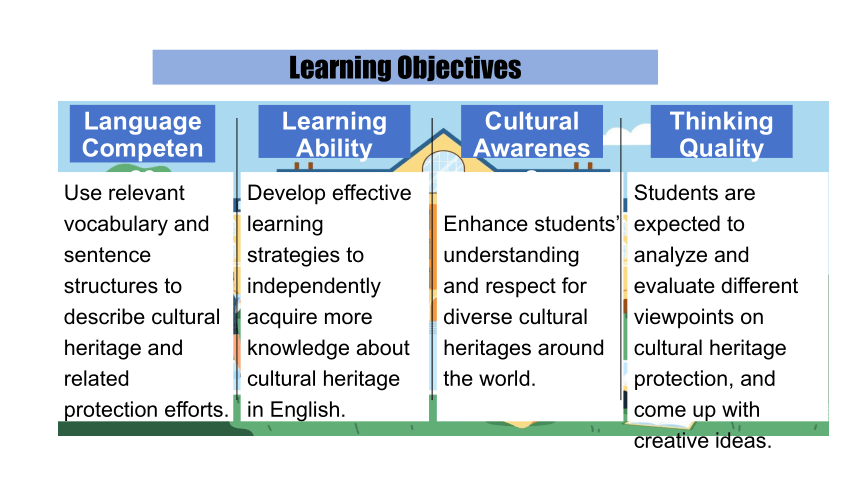
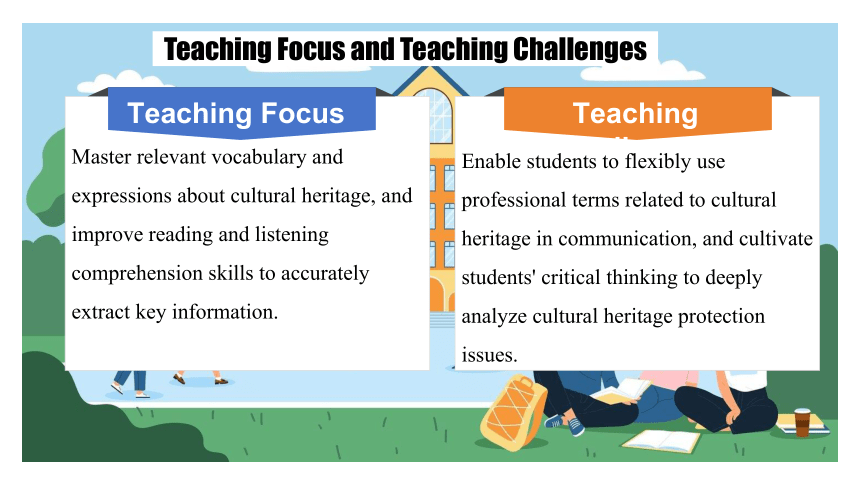
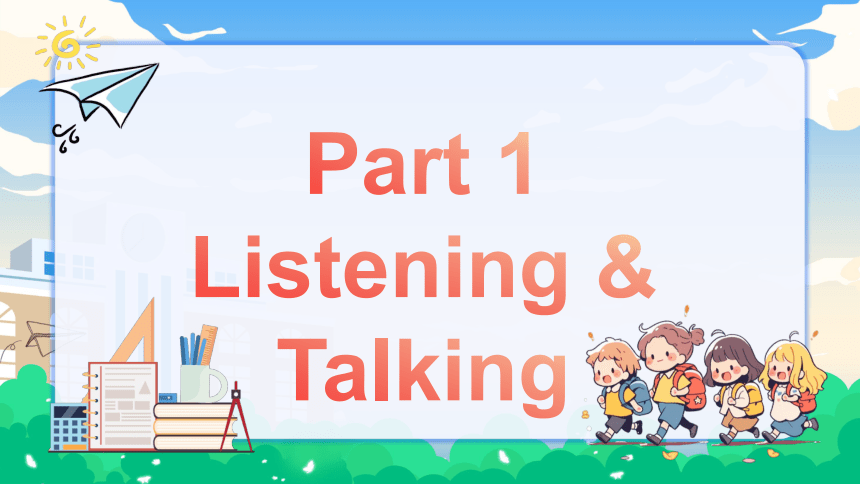
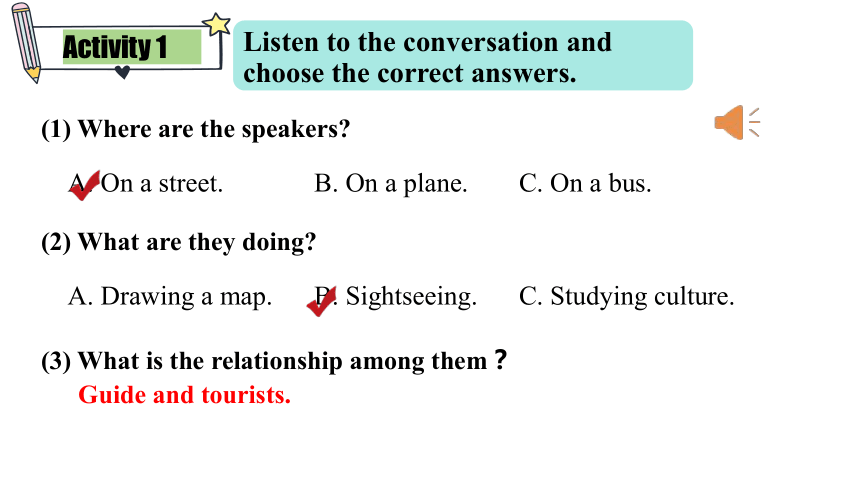
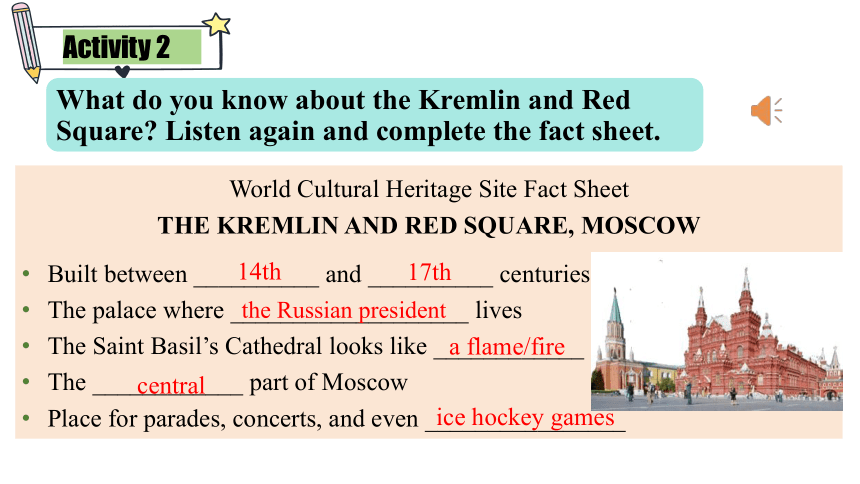

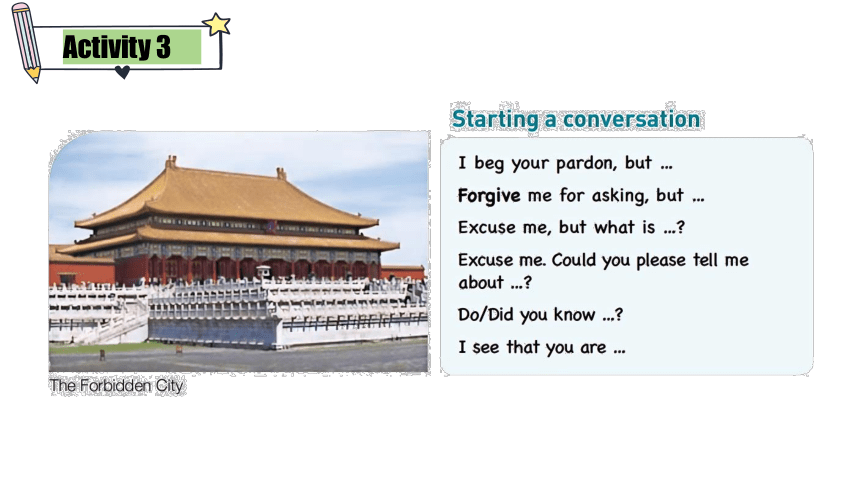
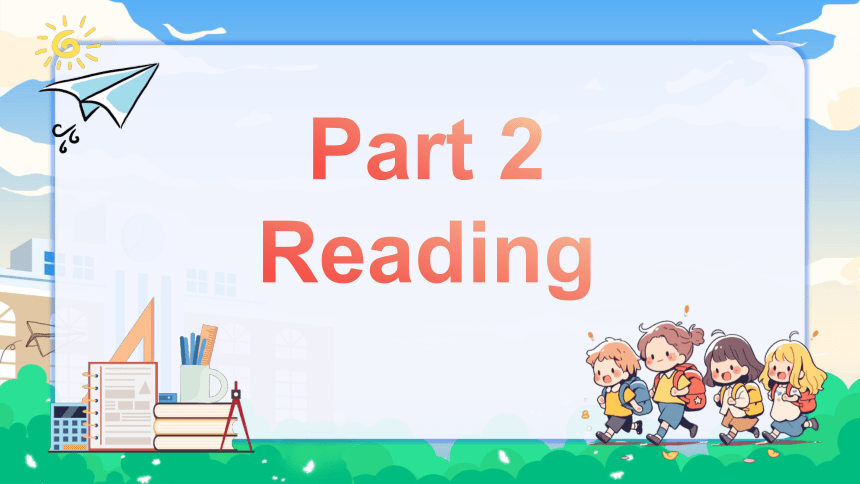


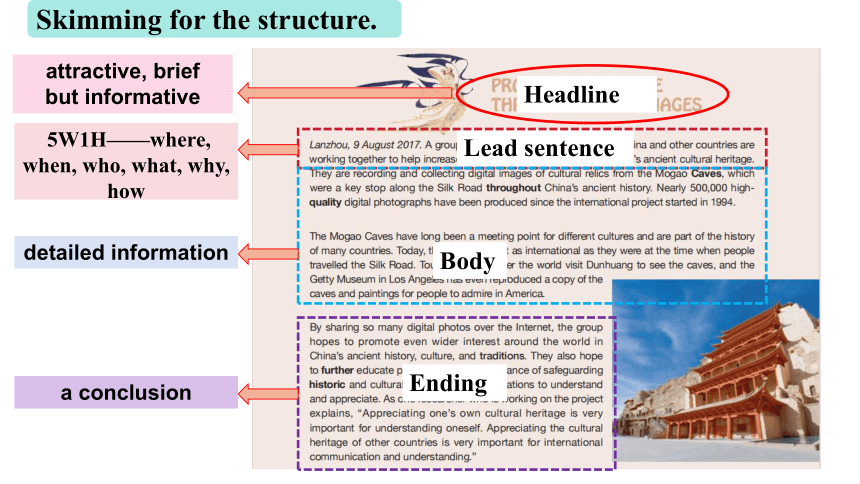
文档简介
(共34张PPT)
Unit 1
Cultural Heritage
Reading for Writing
Language Competence
Use relevant vocabulary and sentence structures to describe cultural heritage and related protection efforts.
Learning Ability
Develop effective learning strategies to independently acquire more knowledge about cultural heritage in English.
Cultural Awareness
Enhance students’ understanding and respect for diverse cultural heritages around the world.
Thinking Quality
Students are expected to analyze and evaluate different viewpoints on cultural heritage protection, and come up with creative ideas.
Learning Objectives
Teaching Focus
Master relevant vocabulary and expressions about cultural heritage, and improve reading and listening comprehension skills to accurately extract key information.
Teaching Challenges
Enable students to flexibly use professional terms related to cultural heritage in communication, and cultivate students' critical thinking to deeply analyze cultural heritage protection issues.
Teaching Focus and Teaching Challenges
Part 1
Listening & Talking
Activity 1
(1) Where are the speakers
A. On a street. B. On a plane. C. On a bus.
(2) What are they doing
A. Drawing a map. B. Sightseeing. C. Studying culture.
(3) What is the relationship among them?
Guide and tourists.
Listen to the conversation and choose the correct answers.
Activity 2
What do you know about the Kremlin and Red Square Listen again and complete the fact sheet.
World Cultural Heritage Site Fact Sheet
THE KREMLIN AND RED SQUARE, MOSCOW
Built between __________ and __________ centuries
The palace where ___________________ lives
The Saint Basil’s Cathedral looks like ____________
The ____________ part of Moscow
Place for parades, concerts, and even ________________
14th
17th
the Russian president
a flame/fire
central
ice hockey games
Activity 3
Work in groups. Choose a cultural site that you like and role-play a conversation between some tourists and their tour guide. Take turns to play the different roles.
EXAMPLE
Tourist A: I beg your pardon, but is this the Xuanyuan Mirror
Could you please tell me about it
Tour guide: Yes, it is. It is said that it’s a mirror that can tell right from wrong!
… I see that you’re looking at that carving on the roof. Did you know that it’s called chiwen—one of the nine sons of the Chinese dragon
Tourist B: No, I didn’t. That’s so interesting!
Activity 3
Part 2
Reading
Lead-in
Guess which city it is!
It is an ancient city on the Silk Road, connecting China with Central Asia and the West.
It is an ancient city on the Silk Road, connecting China with Central Asia and the West.
It lies at the western end of the Hexi Corridor, controlling two important ancient gates: Yumen Pass and Yangguan Pass.
In ancient times, it was a vital hub for trade, where Chinese silk, tea, and porcelain were exchanged for spices, jewels, and cultures.
Lead-in
What do you know about Mogao Caves of Dunhuang
洞窟
彩塑
壁画
Skimming for the structure.
Lead sentence
Body
Headline
Ending
attractive, brief
but informative
5W1H——where, when, who, what, why, how
detailed information
a conclusion
Read para.1 and find the information.
9 August 2017
Lanzhou
500,000 high-quality digital photographs
record and collect digital images
increase knowledge and appreciation of China's ancient cultural heritage
A group of researchers and scientists from China and other countries
a key stop along the Silk Road…
Read para.2 and find the information.
Aspect Details
Cultural Significance The Mogao Caves have long been a meeting point for different cultures and are part of the history of many countries.
Historical Continuity Today, the caves are just as international as they were at the time when people travelled the Silk Road.
Tourism Impact Tourists from all over the world visit Dunhuang to see the caves.
Global Reach The Getty Museum in Los Angeles has even reproduced a copy of the caves and paintings for people to admire in America.
Add authoritative credibility through an expert's voice
Create emotional resonance by personalizing the message
Emphasize the dual significance of cultural appreciation
Make the abstract concepts more concrete and memorable
Provide a natural conclusion that summarizes the text's core thesis
Read para.3 and answer the question.
As one researcher who is working on the project explains, “Appreciating one’s own cultural heritage is very important for understanding oneself. Appreciating the cultural heritage of other countries is very important for international communication and understanding.”
What’s the purpose of using a direct quote
Study the organisation and language features.
Lead sentence (导语 )
Direct quote (直接引用语,引用某人说的话,增强说服力)
Paraphrase (解释,对专业词汇简要解释)
Background information (背景信息,帮助读者更好地理解事件)
E. Reporting verbs (引述动词 ,直接或转述引用的动词,如say, tell, explain, suggest等)
F. Words to show comparison and/or contrast (表示比较或对比的词,如as…as…,than 等)
1. Read the news report again and find these parts.
A Lead sentence
C Paraphrase
D Background
information
F Words to show comparison or contrast
E Reporting verbs
B Direct quote
1. Read the news report again and find these parts.
2. Underline the relative clauses that the writer uses to identify the following.
A. Things
B. people
C. time
Part 3
Writing
写作积累
headline
lead
body
ending
brief, concentrated, eye-catching
when, where, who, what
details of the event
summary
News
structure
导语,第一段或第一句话,简明扼要揭示核心内容
主体,利用充分的事实对导语作进一步阐述
结尾,概括性的总结
写作积累
常用过渡词
1. 表示时间顺序
1. 首先:Firstly/First of all/To begin with/To start with...
2. 其次:Secondly/What's more/Besides/In addition.../afterward
3. 最后:Thirdly/Finally/Last but not least...
2. 表示因果关系
because 因为 due to 由于 as a result 结果
therefore 因此 consequently 因而 so 所以
写作积累
常用过渡词
3. 对比与转折
however 然而 but 但是 while 虽然
in contrast 相比之下 nevertheless 尽管如此 on the other hand 另一方面
4. 表示递进与补充
additionally 此外 furthermore 而且 moreover 再者
besides 除此之外
5. 表示目的
to 为了 in order to 为了 aiming to 旨在
Writing
Write a news report about a person or group who works to protect our cultural heritage. You can use the interview notes below or write about a person or group that you know of.
1 Read the interview notes.
Writing
2 Draft a news report in which you explain what the person or group does.
Writing
Write a news report about a person or group who works to protect our cultural heritage.
Sample
Headline
A Picture Is Worth a Thousand WordsLead Sentence
Lead sentence
Chen Lei is a senior teacher who takes photos of old buildings in Wuhan in order to preserve the city's cultural heritage.
Body
Every day, Chen Lei takes his camera and walks patiently through the older parts of the city. Over the years he has taken thousands of pictures of old buildings to create a record for his fellow citizens in the present and future. Another important part of his project are the interviews he conducts with elderly residents.
Writing
Write a news report about a person or group who works to protect our cultural heritage.
Sample
“Often these stories help to bring the interesting histories of the buildings to life, giving them their place in the human stories of Wuhan's citizens,” says Chen Lei. He writes about the buildings, their inhabitants and the stories that weave them together. He also visits schools to tell students about their cultural heritage.
Ending
Neither people nor buildings last forever, but Chen Lei's photos can help us remember them. The stories that accompany them also help build a picture of life for future generations to hear and add their own stories, too.
Part 4
Assessing
Your Progress
Activity 1
How can you take part in cultural heritage protection Read the passage. Then complete the phrases below and use them to finish the passage.
vast remote fascinating territory bless accompany appeal to
in to from a balance sure
be proud ______
donate sth ______
make _______
keep ________
lead ______
turn_______
prevent ______
take part______
to
a balance
from
to
to
in
to
sure
Activity 1
Getting young people to ____________ activities to protect their national heritage is a good way to introduce them to their country′s history. As they learn more about where they come from,they will hopefully ___________ tell others about their country and culture. Of course,teachers must
______________ between teaching the good and bad parts of a country′s history. Learning only the good parts can __________ narrow thinking. Learning the bad parts may help _______________ those kinds of things ___________ happening again.
take part in
be proud to
keep a balance
lead to
prevent
from
Activity 1
Students who know their history and culture are more likely to _____________ that their cultural heritage is protected,and teachers can motivate students by asking them to come up with their own ideas and make proposals for ways to protect this. One possible idea is for students to raise or _______ money _____ an organisation or group that protects their country′s cultural heritage. Teachers may also _________ their local museums or historical societies for help in getting students more interested in this important field.
make sure
turn to
donate
to
Activity 2
Read the conversation and learn about intangible cultural heritage (ICH). Then complete it with the correct relative pronouns or adverbs.
A:My teacher just gave us a task _____________ I really don′t know how to do. I have to take part in an organization___________ protects our cultural heritage.
(that/ which)
that/ which
B:Oh, that sounds interesting! Where are you planning to go I′m sure there are all kinds of historic sites______________ cultural relics need to be protected.
where/whose
Activity 2
A:Yes, but I′m not one of those people _________ love museums. I think they′re kind of boring. I like going on field trips _____________ I can experience and do things to protect cultural relics.
who
where/on which
B:Cultural heritage is a lot more than just relics, you know. For example, our country has many nationalities dances, ___________ crafts, and other traditions are also very important. If we don′t protect those traditions, there
may come a time ___________ they disappear.
whose
when
Homework
1. Summarise what we have learnt in this lesson;
2. Prepare for the next lesson
See you next time!
Unit 1
Cultural Heritage
Reading for Writing
Language Competence
Use relevant vocabulary and sentence structures to describe cultural heritage and related protection efforts.
Learning Ability
Develop effective learning strategies to independently acquire more knowledge about cultural heritage in English.
Cultural Awareness
Enhance students’ understanding and respect for diverse cultural heritages around the world.
Thinking Quality
Students are expected to analyze and evaluate different viewpoints on cultural heritage protection, and come up with creative ideas.
Learning Objectives
Teaching Focus
Master relevant vocabulary and expressions about cultural heritage, and improve reading and listening comprehension skills to accurately extract key information.
Teaching Challenges
Enable students to flexibly use professional terms related to cultural heritage in communication, and cultivate students' critical thinking to deeply analyze cultural heritage protection issues.
Teaching Focus and Teaching Challenges
Part 1
Listening & Talking
Activity 1
(1) Where are the speakers
A. On a street. B. On a plane. C. On a bus.
(2) What are they doing
A. Drawing a map. B. Sightseeing. C. Studying culture.
(3) What is the relationship among them?
Guide and tourists.
Listen to the conversation and choose the correct answers.
Activity 2
What do you know about the Kremlin and Red Square Listen again and complete the fact sheet.
World Cultural Heritage Site Fact Sheet
THE KREMLIN AND RED SQUARE, MOSCOW
Built between __________ and __________ centuries
The palace where ___________________ lives
The Saint Basil’s Cathedral looks like ____________
The ____________ part of Moscow
Place for parades, concerts, and even ________________
14th
17th
the Russian president
a flame/fire
central
ice hockey games
Activity 3
Work in groups. Choose a cultural site that you like and role-play a conversation between some tourists and their tour guide. Take turns to play the different roles.
EXAMPLE
Tourist A: I beg your pardon, but is this the Xuanyuan Mirror
Could you please tell me about it
Tour guide: Yes, it is. It is said that it’s a mirror that can tell right from wrong!
… I see that you’re looking at that carving on the roof. Did you know that it’s called chiwen—one of the nine sons of the Chinese dragon
Tourist B: No, I didn’t. That’s so interesting!
Activity 3
Part 2
Reading
Lead-in
Guess which city it is!
It is an ancient city on the Silk Road, connecting China with Central Asia and the West.
It is an ancient city on the Silk Road, connecting China with Central Asia and the West.
It lies at the western end of the Hexi Corridor, controlling two important ancient gates: Yumen Pass and Yangguan Pass.
In ancient times, it was a vital hub for trade, where Chinese silk, tea, and porcelain were exchanged for spices, jewels, and cultures.
Lead-in
What do you know about Mogao Caves of Dunhuang
洞窟
彩塑
壁画
Skimming for the structure.
Lead sentence
Body
Headline
Ending
attractive, brief
but informative
5W1H——where, when, who, what, why, how
detailed information
a conclusion
Read para.1 and find the information.
9 August 2017
Lanzhou
500,000 high-quality digital photographs
record and collect digital images
increase knowledge and appreciation of China's ancient cultural heritage
A group of researchers and scientists from China and other countries
a key stop along the Silk Road…
Read para.2 and find the information.
Aspect Details
Cultural Significance The Mogao Caves have long been a meeting point for different cultures and are part of the history of many countries.
Historical Continuity Today, the caves are just as international as they were at the time when people travelled the Silk Road.
Tourism Impact Tourists from all over the world visit Dunhuang to see the caves.
Global Reach The Getty Museum in Los Angeles has even reproduced a copy of the caves and paintings for people to admire in America.
Add authoritative credibility through an expert's voice
Create emotional resonance by personalizing the message
Emphasize the dual significance of cultural appreciation
Make the abstract concepts more concrete and memorable
Provide a natural conclusion that summarizes the text's core thesis
Read para.3 and answer the question.
As one researcher who is working on the project explains, “Appreciating one’s own cultural heritage is very important for understanding oneself. Appreciating the cultural heritage of other countries is very important for international communication and understanding.”
What’s the purpose of using a direct quote
Study the organisation and language features.
Lead sentence (导语 )
Direct quote (直接引用语,引用某人说的话,增强说服力)
Paraphrase (解释,对专业词汇简要解释)
Background information (背景信息,帮助读者更好地理解事件)
E. Reporting verbs (引述动词 ,直接或转述引用的动词,如say, tell, explain, suggest等)
F. Words to show comparison and/or contrast (表示比较或对比的词,如as…as…,than 等)
1. Read the news report again and find these parts.
A Lead sentence
C Paraphrase
D Background
information
F Words to show comparison or contrast
E Reporting verbs
B Direct quote
1. Read the news report again and find these parts.
2. Underline the relative clauses that the writer uses to identify the following.
A. Things
B. people
C. time
Part 3
Writing
写作积累
headline
lead
body
ending
brief, concentrated, eye-catching
when, where, who, what
details of the event
summary
News
structure
导语,第一段或第一句话,简明扼要揭示核心内容
主体,利用充分的事实对导语作进一步阐述
结尾,概括性的总结
写作积累
常用过渡词
1. 表示时间顺序
1. 首先:Firstly/First of all/To begin with/To start with...
2. 其次:Secondly/What's more/Besides/In addition.../afterward
3. 最后:Thirdly/Finally/Last but not least...
2. 表示因果关系
because 因为 due to 由于 as a result 结果
therefore 因此 consequently 因而 so 所以
写作积累
常用过渡词
3. 对比与转折
however 然而 but 但是 while 虽然
in contrast 相比之下 nevertheless 尽管如此 on the other hand 另一方面
4. 表示递进与补充
additionally 此外 furthermore 而且 moreover 再者
besides 除此之外
5. 表示目的
to 为了 in order to 为了 aiming to 旨在
Writing
Write a news report about a person or group who works to protect our cultural heritage. You can use the interview notes below or write about a person or group that you know of.
1 Read the interview notes.
Writing
2 Draft a news report in which you explain what the person or group does.
Writing
Write a news report about a person or group who works to protect our cultural heritage.
Sample
Headline
A Picture Is Worth a Thousand WordsLead Sentence
Lead sentence
Chen Lei is a senior teacher who takes photos of old buildings in Wuhan in order to preserve the city's cultural heritage.
Body
Every day, Chen Lei takes his camera and walks patiently through the older parts of the city. Over the years he has taken thousands of pictures of old buildings to create a record for his fellow citizens in the present and future. Another important part of his project are the interviews he conducts with elderly residents.
Writing
Write a news report about a person or group who works to protect our cultural heritage.
Sample
“Often these stories help to bring the interesting histories of the buildings to life, giving them their place in the human stories of Wuhan's citizens,” says Chen Lei. He writes about the buildings, their inhabitants and the stories that weave them together. He also visits schools to tell students about their cultural heritage.
Ending
Neither people nor buildings last forever, but Chen Lei's photos can help us remember them. The stories that accompany them also help build a picture of life for future generations to hear and add their own stories, too.
Part 4
Assessing
Your Progress
Activity 1
How can you take part in cultural heritage protection Read the passage. Then complete the phrases below and use them to finish the passage.
vast remote fascinating territory bless accompany appeal to
in to from a balance sure
be proud ______
donate sth ______
make _______
keep ________
lead ______
turn_______
prevent ______
take part______
to
a balance
from
to
to
in
to
sure
Activity 1
Getting young people to ____________ activities to protect their national heritage is a good way to introduce them to their country′s history. As they learn more about where they come from,they will hopefully ___________ tell others about their country and culture. Of course,teachers must
______________ between teaching the good and bad parts of a country′s history. Learning only the good parts can __________ narrow thinking. Learning the bad parts may help _______________ those kinds of things ___________ happening again.
take part in
be proud to
keep a balance
lead to
prevent
from
Activity 1
Students who know their history and culture are more likely to _____________ that their cultural heritage is protected,and teachers can motivate students by asking them to come up with their own ideas and make proposals for ways to protect this. One possible idea is for students to raise or _______ money _____ an organisation or group that protects their country′s cultural heritage. Teachers may also _________ their local museums or historical societies for help in getting students more interested in this important field.
make sure
turn to
donate
to
Activity 2
Read the conversation and learn about intangible cultural heritage (ICH). Then complete it with the correct relative pronouns or adverbs.
A:My teacher just gave us a task _____________ I really don′t know how to do. I have to take part in an organization___________ protects our cultural heritage.
(that/ which)
that/ which
B:Oh, that sounds interesting! Where are you planning to go I′m sure there are all kinds of historic sites______________ cultural relics need to be protected.
where/whose
Activity 2
A:Yes, but I′m not one of those people _________ love museums. I think they′re kind of boring. I like going on field trips _____________ I can experience and do things to protect cultural relics.
who
where/on which
B:Cultural heritage is a lot more than just relics, you know. For example, our country has many nationalities dances, ___________ crafts, and other traditions are also very important. If we don′t protect those traditions, there
may come a time ___________ they disappear.
whose
when
Homework
1. Summarise what we have learnt in this lesson;
2. Prepare for the next lesson
See you next time!
